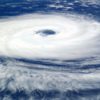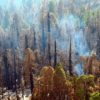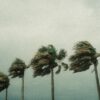1) 90% of wildfires are human-caused
Sources of anthropogenic wildfires are most often accidental ignition by campers, hikers, or garbage/debris burns…but some are purposely started by arsonists..
2) But the majority of acres burned comes from lightning ignitions
Because they often occur in isolated locations with limited access, lightning fires burn more total acres than human-caused starts. The average 10-year total of U.S. wildfire acres burned by human cause is 1.9 million acres; 2.1 million acres burned are lightning caused. If a lightning fire is not endangering life or property, the US Forest Service will allow the fire to burn under the Fire Use Guidelines.
3) Prolonged drought plus a freeze event can prompt wildfires in non-typical seasons.
When a freezing weather event hits a wildfire-prone area during drought conditions, it can dry fuels to the point of extreme ignitability. Despite low temperatures, wildfires can frequently still burn when these conditions exist.
4) Aircraft don’t put out the fire, they slow the rate of spread
Though news outlets heavily cover firefighting aircraft during a wildfire, the retardant these planes drop will rarely extinguish the flames. The retardant is designed to slow the fire’s rate of spread so as to allow ground forces enough time for a direct attack. Retardant is a fertilizer-based product that is able to adhere to vegetation, requiring more heat for ignition. The fertilizer is colored red for higher visibility to tanker pilots to see where the last drop was placed.
5) Smoke color depicts fire fuel types
Smoke is the biproduct of the fuels it is burning, and the color of the smoke is often used as an indicator to firefighters of the type and density of the fuels that are involved. White smoke generally indicates light flashy fuels such as grass or twigs. Thick black smoke indicates heavy fuels that are not being fully consumed. At times thick black some can be an indicator that a manmade substance is burning such as tires, vehicles or a structure. Grey smoke can indicate that the fire is slowing down and running out of materials to burn.
6) The Story of Edward Pulaski
Edward Pulaski was a Forest Ranger in Wallace, Idaho, and is most known for saving the lives of 40 men during the Great fire of 1910. When the fire broke out of control and overwhelmed his crew, he directed his men into a cave and held them at gunpoint so they wouldn’t leave. After the fire had passed, the men came to the entrance to find the ranger covered in debris and thought he was dead. Pulaski arose and stated “Like hell I am.” A firefighting tool pulaski tool he designed was later named after him and is still used today.
7) Post-wildfire mudslides are common
A fast-moving, highly destructive debris flow can occur within a few years after wildfires scorch the soil and roots of vegetation in a particular area, especially in steep terrain. Most occur in response to high intensity rainfall events and are particularly dangerous as they sometimes happen with very little warning.
8) Peshtigo Fire in 1871 killed over 1,200 people
On October 7th, 1871, the most devastating US wildfire started in Peshtigo, Wisconsin. 1,200 people were confirmed killed and the entire town of Peshtigo was destroyed. The fire started when several small burns grew out of control due to high winds. The fire eventually burned over 1.2 million acres. This is the highest recorded death total for a wildland fire.
9) Wildfires are important for the forest ecosystem
Forest ecosystems depend on wildfires to thin the forest canopy allowing saplings near the forest floor access to sunlight. Some plants and trees require fire and heat in order for their seeds to germinate. Fire can eliminate certain plants while allowing fire-resistant species to survive and thrive.
10) Large wildfires are capable of creating their own localized weather
Wildfires generate their own winds as they grow in size. These winds will pull air into the fire as they burn more fuel. Intense heating of air from the surface induces convection, which causes an air mass to rise above the fire and, in the presence of moisture, can form pyro cumulus clouds.
Sources include: The History Channel, Wikipedia, Accuweather, Smokey Bear, USGS, about.com, & Spokane Chronicle
![]()



